How And Why Teeth Wear
Understanding The Basics Of How Your Bite Works
(Continued)
Excessive wear can also lead to “bite collapse,” with associated facial changes that produce sagging cheeks, and creasing of the lips at the corners of the mouth — all manifestations of lessening lower face height which accentuate the aging process.
Oral Habits: Parafunctional forces can also impact the teeth through other interesting habits.
- Tooth-to-tooth habits include clenching and grinding, a common sign of psychological stress that occurs unconsciously, for example, during sleep. Unless they are causing symptoms, many people are often totally unaware they grind their teeth until pointed out by a dental professional.
- Tooth-to-foreign body habits encompass a broad range of objects that individuals habitually hold between their teeth like nails, pencils, bobby pins and more, that can create damage and wear. They can both move teeth and cause abnormal wear patterns.
- Tooth-to-soft tissue habits, such as thumb or finger sucking, are unlikely to cause wear; however, they can cause irregularities in bite and swallowing patterns.
| Examples of Tooth Wear and Restorations | |
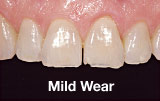 |
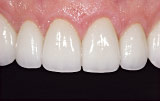 |
| An example of mild wear of the edges of the upper front teeth resulting in thinning and chipping of the enamel surfaces. | The upper front teeth are restored with porcelain veneers re-establishing the normal thickness and length. |
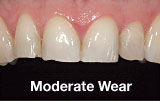 |
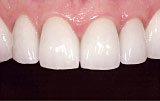 |
| An example of wear with a moderate loss of tooth length exposing the underlying softer dentin surface of the tooth. | Restoration of the worn teeth with porcelain crowns (or veneers) re-establishing normal shape, function and appearance. |
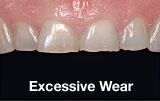 |
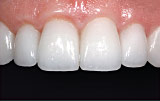 |
| An example of excessive wear, that often results in the loss of facial height and other features of aging. | Crowning excessively worn teeth does not only re-establish correct tooth shape and function, but can also dramatically improve tooth color and facial appearance, resulting in a more harmonious younger look. |
| Photos provided by Dr. Michael R. Sesemann | |
Where Does Wear End?
Tooth wear is basically the result of four different and frequently combined processes:
- Abrasion: Wear produced by interaction between teeth and other materials
- Attrition: Wear through tooth-to-tooth contact
- Erosion: Dissolution by acidic substances
- Abfraction: Another form of loss of tooth structure that may have a wear component. It is associated with enamel loss at the necks (at the gumline) of the teeth. There are many factors that can contribute to abfraction simultaneously including abrasion and erosion.
The Fix — Dependant On The Cause
As in most areas of medicine, treating a problem means getting to the root of its cause in order for treatment to be effective. With tooth wear it is not only necessary to replace the tooth structure lost through wear, but also to make sure that the corrected bite is properly restored in terms of form, function, normal tooth shapes and aesthetics. Once corrected, a properly aligned and functional bite should continue into the future without further destroying itself. If abnormal tooth wear is evident from parafunctional habits (clenching and/or grinding), it is both appropriate and necessary to provide therapy through a variety of techniques to reduce the likelihood of further damage. One preventive and treatment option includes wearing a professionally made mouthguard (occlusal guard) during periods of stress or sleep that is specifically designed to protect the teeth when the damaging activity typically occurs. This simple step can result in improved oral health and social/psychological well-being.
Examples of individuals (on the opposite page) with early, moderate and advanced wear of the upper front teeth show “before” and “after” treatment results. They show how modern dentistry can successfully restore the normal shape, appearance and function of worn teeth.





